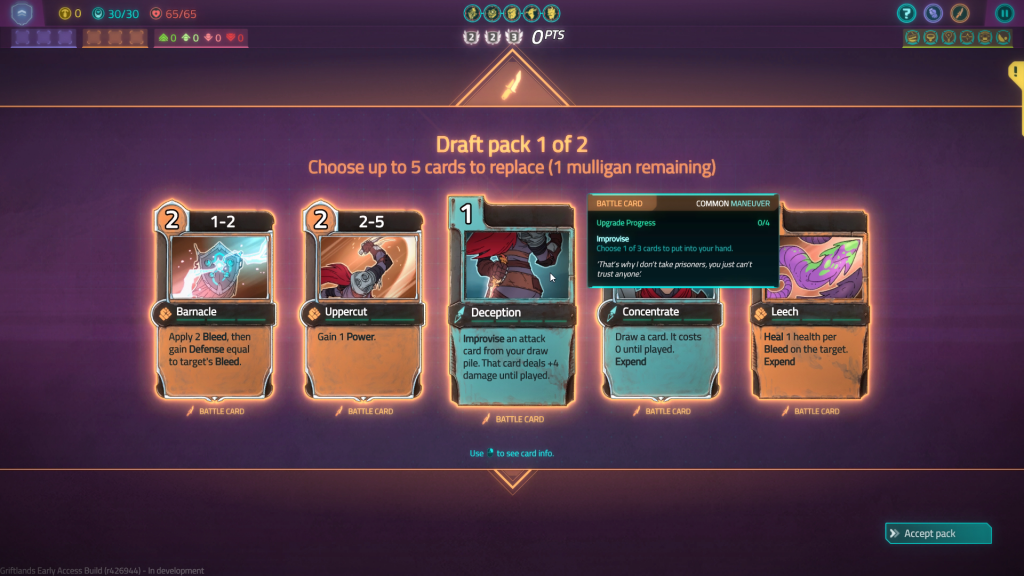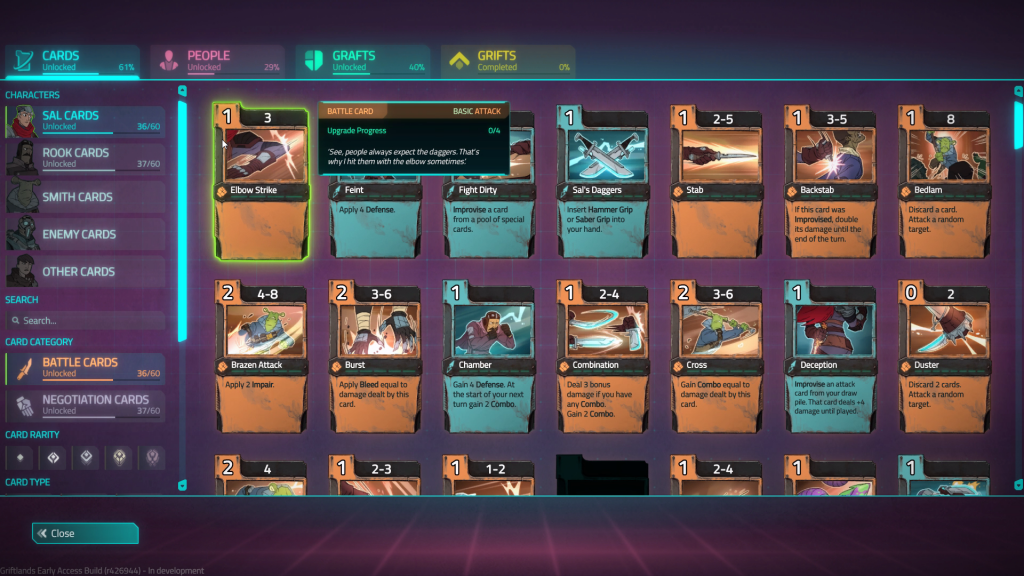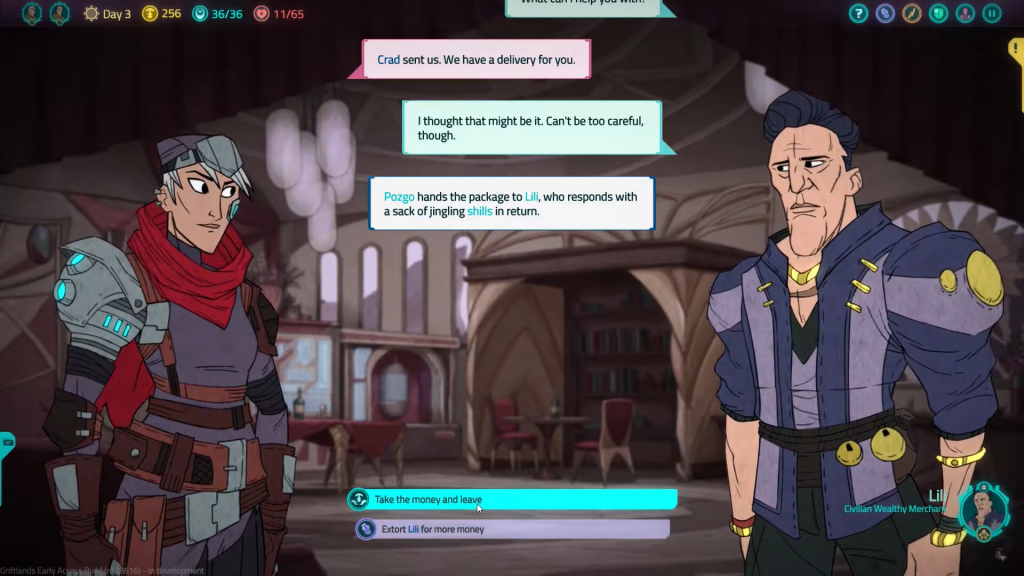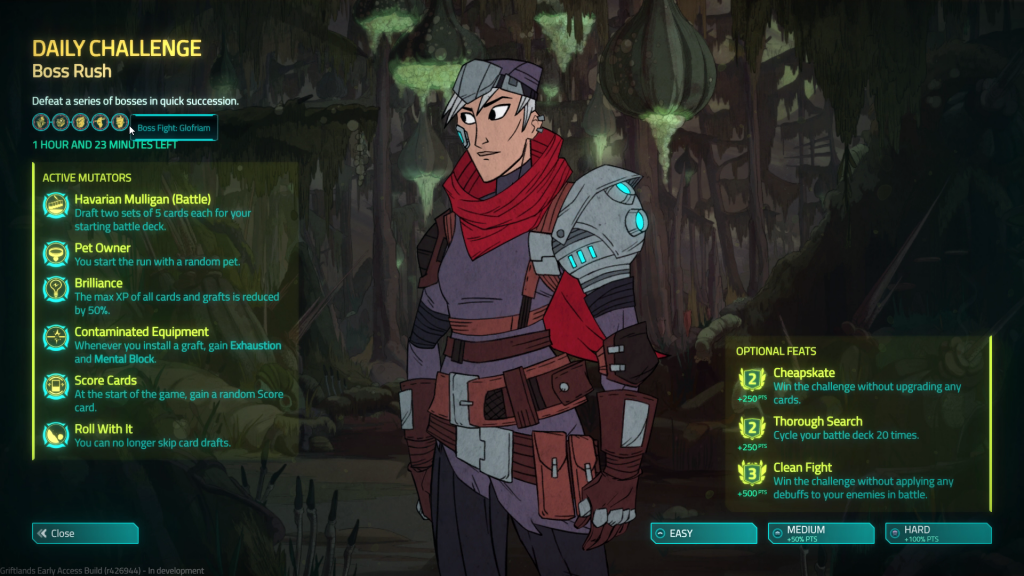Griftlands Early Access — Is It Worth It?
Early Access is so often little more than a grift; a calculated money grab intent on screwing the players over little more than a promising idea – but that has not been the case with Klei Entertainment’s previous games, and it certainly isn’t with the developer’s latest.
My own history with Klei is paradoxical – I love their games, and yet I have played very few of them past the opening several hours, either in terms of content or progression. Yet it’s impossible to argue that games such as Mark of the Ninja, Oxygen Not Included, and especially Don’t Starve have achieved not only cult status but mainstream appeal. They all bear the marks of Klei’s work on them—and so does Griftlands, in every aspect, from the dirge of content to the signature hand-drawn art style, to the addictive gameplay loop.
In this video(and in the script you are now reading), I will examine two questions, one on the nature of Griftlands, and the second, on whether purchasing it in Early Access is a worthwhile move, judging by what is currently included in this seventeen euro package. Without further ado, let’s get to it!
What is Griftlands?
Griftlands is the latest game in a series of rogue-lite deckbuilders that have come out over the last several years, following in the steps of such genre-defining pioneers as Slay the Spire, developed by MegaCrit. But where Slay the Spire aimed for extracting the essence of dungeoneering to its basic building blocks – tense, unforgiving encounters – Klei Entertainment’s aims are at once more ambitious and aimed in a different direction.
What Griftlands attempts is a deckbuilder that doesn’t only dabble in half-glimpsed lore in the vein of Slay the Spire but attempts to create whole unique playthroughs based on modular stories. Lee Sheldon developed the concept of modular storytelling in his book, Character Development and Storytelling for Games, and the way he defines it is as an overarching story that runs throughout an entire piece, but between the few points set in stone that give the framing of this story are isolated incidents, or modules, which change from one playthrough to another. Some of these modules can be interconnected, but most of them won’t be.
In pursuing this modular storytelling, Klei Entertainment has created dozens of quest archetypes and interaction templates between the player character and the hundreds of different NPCs – in preparation for this video, I’ve played over thirty hours of Griftlands and still I come across scenarios, quests or NPC interactions that surprise and delight me. It is true that I have also played through several repetitive beats, for example, limited time events that asked me to step in and save a friendly NPC or watch on as they were killed. Each repetition did take away from the immediacy of something called “A LIMITED TIME EVENT” but that’s one of the sacrifices developers make at the altar of randomly generated content, modular or otherwise.
Despite the negatives, this mode of storytelling is largely successful—at least for dozens of hours and several playthroughs. Part of it has to do with the atmosphere Griftlands creates. There’s something of the Wild West here, in the way both playable characters, Sal and Rook, approach the issues they are faced with, and both Murderer’s Bay and the Bog have plenty of character on their own, which on both occasions serve to ground the stories told in dirt, grit and iniquity – three things you need for a good Wild West space shoot-out. That, of course, and plenty of spoils – and where there’s scum and villainy….well, for grifters like Sal and Rook, there’s coin and opportunity in equal measure. The tension between several powerful factions all aiming to advance themselves at the expense of all others creates an atmosphere perfect for the hustlers, whether their tools be blasters, blades, or words.
But before I dig my own hole here, and spend several long paragraphs discussing the characters and worldbuilding, I’ll attempt to break down the mechanical side of things.
Deckbuilder Mechanics (Are Fun, I Promise!)
 A narrative roguelike deckbuilder is an ambitious proposition in its own right. I’ve covered the narrative element already; then, we’ve got the deckbuilder and roguelike aspects to elaborate on.
A narrative roguelike deckbuilder is an ambitious proposition in its own right. I’ve covered the narrative element already; then, we’ve got the deckbuilder and roguelike aspects to elaborate on.
Roguelike is simple enough – every time you die, you begin a new run, having lost the progress you made previously. That said, with every playthrough (successful or not), you will unlock certain bonuses. These include an incremental increase in quality through Mastery levels; cosmetic outfits for your character; new cards; and Mutators, which, if you so choose, introduce elements to your game which will alter the experience in countless ways. In the sense that you still accomplish some longer-term progression, Griftlands is more of a ‘rogue-lite,’ but as this term doesn’t seem to endure as well as ‘roguelike,’ I’ve subscribed to using the latter one.
Among the biggest selling points for Griftlands is the existence of not one deck to shape and play with, but two. In addition to the combat deck, there’s also the diplomacy or negotiation deck, used whenever you attempt to persuade, intimidate or otherwise coerce an NPC. It’s a refreshing way to engage in arguments, and I applaud the idea. What’s better is, the execution is wickedly fun.
Negotiation cards can be broken up into three groups: Influence, Aggression and Manipulation. The first kind does a moderate amount of damage, evenly spread out, while the second has the capacity for stronger blows, but also weaker ones; Influence will often offer positive effects to you, while Aggression will yield negative conditions on the enemy. Manipulation doesn’t do damage but rather offers support cards and interesting gimmicks which might work to synergize either or both of the other types of cards. Try and remember the three types – we’ll get back to them a little later.
I’m partial to the combat deck, as well – the visual elements of the positioning of the player character, their allies and their foes, in particular, reminds me of the turn-based Final Fantasy games, some of which I continue to replay to this day. The combat gameplay itself is intuitive, far more so than the negotiation battles.
With every victory you claim comes an additional card, either for your battle or for your diplomacy deck. In the case of boss battles, for both. You pick from three cards, [as in Slay the Spire], but have the opportunity to forego increasing your deck for the sake of a small sum of money. To paraphrase Extra Credits, the deck-building is part of the gameplay, rather than just the meta-gaming. It is a strategic decision; speaking of such decisions, Adam Millard, the Architect of Games (you should check his channel out, it’s brilliant!) outlines three requisites for a good deckbuilder:
- The cards need to enable synergy;
- They need to create interesting decisions in the long-term;
- The cards need to have a distinct identity.
Let’s break each point and how it relates to Griftands.
- The cards need to enable synergies.
Griftlands is firmly in the camp of deckbuilders which make use of ‘hard synergy’, which is to say, they demand you commit to a certain mechanic that is reinforced by the vast majority of the other cards in your deck. That mechanic can be, for example, the Combo mechanic with Sal, which will ask you to build up combo, and then unleash devastating Finisher attacks which make full use of the combo points. I’ll talk about Rook’s synergy in the next section; for now, let’s move onto the second point.
- They need to create interesting decisions in the long-term – i.e. they need to offer a strategic dimension to more than just one battle, or several; they need to inform your own decision-making, which, I would argue, is done through the hard synergy in the first place.
Now, onto our last point:
- The cards need to have a distinct identity.
 This, I’m afraid, is where Griftlands struggles a little. The cards synergize well, choosing them very much shapes the long-term direction of your run, but if I told you they had an identity, I would do so with my eyes squinted ever so slightly, trying to remember what exactly that identity is. There’s flavour text to these cards, but it doesn’t jump out in the act of playing—just now, in fact, I went back and reread some of that text, and I was surprised to find a lot of it funny. Not laugh-out-loud funny, necessarily, but amusing; besides, the art is of a consistently high quality. Yet there’s something understated about the identity of these cards, and I wonder if the folks at Klei could do more to underline it, to give it feet to stand on. The cards are simply not exciting, not in the way the cards in Hearthstone or Magic the Gathering are.
This, I’m afraid, is where Griftlands struggles a little. The cards synergize well, choosing them very much shapes the long-term direction of your run, but if I told you they had an identity, I would do so with my eyes squinted ever so slightly, trying to remember what exactly that identity is. There’s flavour text to these cards, but it doesn’t jump out in the act of playing—just now, in fact, I went back and reread some of that text, and I was surprised to find a lot of it funny. Not laugh-out-loud funny, necessarily, but amusing; besides, the art is of a consistently high quality. Yet there’s something understated about the identity of these cards, and I wonder if the folks at Klei could do more to underline it, to give it feet to stand on. The cards are simply not exciting, not in the way the cards in Hearthstone or Magic the Gathering are.
Rather than from the cards, the game’s identity bleeds from the world and characters – and now would be a good time to double-back and talk about Sal and Rook, and the world they inhabit.
Two Characters, Two Maps, a Dozen Styles of Play Between Them

I love how much agency you, the player, have in choosing which factions to ally yourself with. Each of the factions, of course, has its own dedicated NPCs, characteristics, engaging lore, and even specific cards. Or rather, certain cards you’ll gain easier when aligned with one faction versus another.
Identity, as I said, is tied to the characters of Rook and Sal. Excellent news, as personality is one ingredient neither of these two lacks. I won both of their respective campaigns once, although I ended up playing with Rook quite a bit more, as I kept dying and restarting.
Sal is the easier character of the two, the one you’ll want to start the game with – in fact, you’ll have no choice, as you only unlock Rook after you’ve played with her. I’ll share with you a few of my impressions of my first run with her – from my own notes as I reflected back on each day of in-game time I survived, after the fact. I’ve redacted and built on these for the purpose of this video, but bear in mind, they’re still my impressions at a rather early point in the game.
- The negotiation battles are fun enough that I didn’t want to end some of them, eager to see how many negative effects I could stack on the enemy, how many positive conditions I could get on myself at any one time.
- Not only do you get boons when you make friends you also get banes when you make enemies. These force you to adapt and change your playstyle. This, in turn, adds depth similar to—but not quite the same as – the curse cards in Slay the Spire. You can remove banes only by killing the characters who hate you; and some of their effects are quite the deterrents. One, for example, forces you to draw one less card on your first turn of every combat, which reduces your early choices and makes any opening just a hint more challenging.
- The sense of humour at display is at times, absolutely hilarious.
- Very impressed with the final boss; she killed me once, and I restarted the last day before managing to defeat her. She seems to have multiple strategies, which make for a thoroughly engaging final encounter promising plenty of replayability. The modular design in the quests continued right down to the end – a series of events I was almost certain were scripted, turned out to be just another set of modular scenarios. My experience both times was memorable and made for an exhilarating climax.
Rook, in contrast, is a tougher nut to crack.

He’s a lot more reliant on RNG than Sal is, to begin with. So much of his Negotiation deck relies on the literal tossing of a coin—and here we’ve got his core negotiation mechanic, the aptly named “Head or snails.” Poetry, that, and either condition adds special effects to specific cards, which make the blows the old spy unleashes that much more potent. My first playthrough was mired with issues because I didn’t immediately comprehend how to best make use of the mechanic; his starting deck seemed to me considerably weaker than Sal’s. Except, of course, it isn’t; it’s all about how you use it.
An interesting build to attempt with Rook would be not to commit to either heads cards or snails cards—one of the intriguing effects at his disposal allows him to Set the Coin. Since Rook’s Influence and Aggression cards are committed to the heads and snails side of the coin, respectively, you are forced to either commit to gambling, or to attempt to avoid it. The Set the Coin mechanic circumvents all of that; you can now use both Aggression and Influence cards to their fullest extent.
Before we wrap this up, a small aside on the newest feature introduced in the July 2020 update:
The Dailies:
 At the heart of every draft mode lies a simple idea – challenging the player through the random selection of cards he has been dealt. Drafting a beginner deck from random cards is all about seeing how far you can go with the hands fate has dealt; it demands you think on your feet and do your best to synergize cards that don’t necessarily complement one another. It’s a challenge, and it’s rotating content that, while lacking a modular story, does offer replayability. Not my cuppa tea but something tells me, some would enjoy this one more than I did.
At the heart of every draft mode lies a simple idea – challenging the player through the random selection of cards he has been dealt. Drafting a beginner deck from random cards is all about seeing how far you can go with the hands fate has dealt; it demands you think on your feet and do your best to synergize cards that don’t necessarily complement one another. It’s a challenge, and it’s rotating content that, while lacking a modular story, does offer replayability. Not my cuppa tea but something tells me, some would enjoy this one more than I did.
I realize this has been a hell of a response to the first question with which I opened this video. Hopefully I’ve managed to break it down into understandable sections. Now, onto our second question—I promise this one will be shorter.
Is Griftlands worth supporting at this point in its development?
Griftlands succeeds where so many games inspired by Slay the Spire fail because Klei sets its aims towards a different set of core goals than so many other deckbuilder roguelikes have. That’s something Griftlands shares with other unique deckbuilders I’d like to cover, games such as “One Step from Eden”. Each of these games paves its own way. Griftlands does so through a dual deck model and through a narrative-driven experience. I do not think this game has quite the strategic or tactical depth that Slay the Spire does – and perhaps it never will. But—and that’s a big but – it more than makes up for that comparative lack of depth with the phenomenal aesthetics, the memorable world, the characters, the twist introduced via the diplomacy deck.
That is also why the Brawl and Daily modes are weaker – the streamlined experiences lack the story beats that make up the unique identity Griftlands claims in its campaign modes.
Whether those modes appeal to you or not, one thing is certain: Griftlands is well-worth supporting at this point in its Early Access. With an excellent amount of content and the signature Klei art style, with memorable protagonists and an addictive gameplay loop, this game warrants a purchase for everyone who enjoys deckbuilders and roguelikes both.
References:
More on Modular Storytelling here: https://www.gamasutra.com/blogs/David…
Adam Millard’s “What Makes a Great Deckbuilder?” https://www.youtube.com/watch?v=d_gBR…

[…] время на их изучение. В одном из обзоров автор прямо называет карточки скучными и сравнивает их с визуалом Hearthstone […]